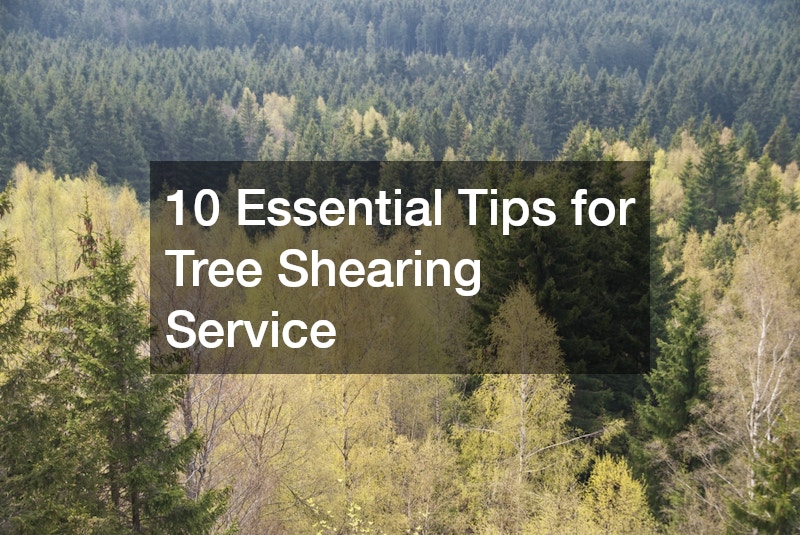Tree shearing is an essential practice for maintaining not only the health but also the aesthetics and safety of trees in both residential and commercial landscapes. Whether you’re a professional arborist or a property owner aiming to keep your trees in peak condition, understanding the fundamentals of tree shearing can greatly enhance your landscape’s overall value and vitality. This technique, often misunderstood or overlooked, involves the careful pruning and trimming of trees to promote optimal growth, structural integrity, and beauty. From promoting robust growth to preventing hazards during storms, the benefits of tree shearing are multifaceted. Additionally, professional tree service providers often recommend shearing as a part of comprehensive property maintenance. As the demand for responsible and effective tree care grows, more individuals and businesses are turning to tree shearing to meet their needs. This article outlines ten essential tips for tree shearing that address both common concerns and expert insights.
1. What is Tree Shearing and Why is it Important?

Tree shearing refers to the strategic cutting or trimming of trees, typically to improve health, aesthetics, and safety. This process involves removing certain branches or limbs to stimulate healthier growth patterns and remove dead or diseased wood. It’s a critical practice that forms part of a broader tree service, especially for property owners looking to maintain the integrity of their green spaces. Tree shearing helps guide the tree’s shape and structure, allowing it to grow more evenly and symmetrically. Beyond visual appeal, proper shearing reduces the risk of branches breaking off during high winds or storms, which can lead to storm damage and property hazards. When performed correctly, tree shearing can prevent the need for costly tree removals down the line. Additionally, well-maintained trees contribute to environmental benefits such as carbon sequestration, air purification, and habitat preservation. Tree shearing is also essential for commercial properties, where trees must meet safety codes and aesthetic standards. A local tree company typically offers shearing as a standard service due to its proven value in maintaining tree vitality. In essence, tree shearing is about proactive care that safeguards both the tree and the surrounding environment. Investing in proper tree shearing ensures that trees live longer, healthier lives while enhancing the landscape’s overall appearance.
2. How Often Should Trees be Sheared?
The frequency of tree shearing depends on several factors, including the species of the tree, its growth rate, and the desired outcomes of the shearing process. Some trees, especially fast-growing varieties, may require shearing once or twice a year, while slower-growing species may only need attention every few years. Understanding the tree’s natural growth habits is key to determining the ideal shearing schedule. Seasonal changes also influence how often trees should be sheared, with most experts recommending maintenance during dormant periods. It’s essential to monitor your trees regularly to assess whether shearing is necessary, especially after a season of rapid growth or harsh weather. Hiring a local tree company can help you establish a consistent schedule tailored to your specific landscape needs. For ornamental trees, more frequent shearing may be required to maintain their designed shapes and sizes. In contrast, native or shade trees might benefit from less frequent but more strategic pruning. In urban settings, trees near buildings or walkways may also need more regular shearing for safety. Additionally, trees damaged by storms may need immediate shearing to remove weakened limbs and mitigate storm damage. A reliable tree service provider can assess your trees and recommend an appropriate shearing interval. Staying proactive helps ensure your trees remain healthy, beautiful, and safe year-round.
3. What Tools and Equipment are Needed for Tree Shearing?
Effective tree shearing begins with the right tools and equipment. For smaller branches and fine pruning work, pruning shears and loppers are indispensable. Loppers provide the leverage needed for cutting thicker branches while pruning shears are ideal for precision cuts. For more extensive shearing tasks, pole saws and hand saws allow you to reach higher branches without the need for climbing. For larger, mature trees, power tools like chainsaws might be necessary, but these should only be handled by trained professionals due to safety concerns. When dealing with massive or tall trees, some tree service companies may utilize bucket trucks or rely on crane service to safely access difficult areas. Having the right safety gear is equally important-helmets, safety goggles, gloves, and climbing harnesses help protect the individual performing the shearing. Some shearing jobs may even require heavy equipment rentals if the tree is particularly large or positioned on challenging terrain. In such cases, an excavation contractor might be needed to create safe access paths. Using the correct equipment not only ensures the job is done safely but also improves the quality of the shearing cuts, which affects how the tree heals and grows. Local landscapers and professionals often invest in high-quality, well-maintained equipment to ensure efficiency and effectiveness. For property owners, hiring professionals who have access to a full range of tools ensures a safer and more successful shearing process. Proper tools make all the difference when it comes to quality results.
4. When is the Best Time of Year for Tree Shearing?

Timing is crucial when it comes to tree shearing, and the best time typically depends on the species and condition of the tree. However, as a general rule, most trees should be sheared during their dormant season, usually in late winter or early spring. Shearing during dormancy reduces stress on the tree and promotes vigorous growth when the growing season resumes. This period also allows you to better see the tree’s structure, making it easier to plan and execute precise cuts. For flowering trees, the timing might vary-some should be sheared immediately after blooming to avoid cutting off next season’s buds. Tree cutting during active growing periods should be minimal to prevent shock or disease susceptibility. Additionally, shearing after severe weather events, such as storms, is important to remove broken or weakened branches. This not only reduces the risk of further storm damage but also promotes recovery. For larger projects involving land clearing services, winter shearing is often preferred due to the frozen ground, which minimizes soil disruption. In areas with high pest activity, dormant shearing reduces the chance of insect infestation. Consulting with a local tree company helps ensure you pick the best time for shearing based on local climate and tree species. Proper timing enhances the effectiveness and safety of the shearing process. With expert guidance, you can schedule tree shearing at the optimal moment for your landscape.
5. How Does Tree Shearing Promote Tree Health?
Tree shearing plays a vital role in maintaining and enhancing the health of trees. By removing dead, diseased, or overcrowded branches, shearing allows for improved air circulation and light penetration throughout the canopy. These conditions reduce the risk of fungal infections and pest infestations, promoting a healthier growing environment. Shearing also encourages the growth of strong, well-spaced branches that improve the overall structural integrity of the tree. This is particularly important for fruit-bearing trees, as it enhances fruit production and supports the development of sturdier limbs. In urban environments, tree shearing ensures that trees don’t interfere with power lines or structures, reducing safety risks. When performed correctly, tree shearing reduces the likelihood of emergency tree removals due to neglected health issues. Professional tree service providers understand how to balance aesthetic goals with biological needs, ensuring that each cut contributes to long-term vitality. Moreover, healthy trees are better able to withstand extreme weather, drought, and other stressors. When combined with other maintenance like lawn care services and soil management, tree shearing becomes part of a holistic tree care plan. Local landscapers often integrate tree shearing with seasonal yard maintenance to keep landscapes thriving year-round. Ultimately, tree shearing is a proactive way to prevent disease, strengthen resilience, and support sustained growth. Healthy trees benefit not only individual properties but also the larger ecosystem.
6. Can Tree Shearing Enhance the Aesthetic Appeal of My Landscape?
Absolutely-tree shearing is a key strategy in enhancing the visual appeal of your landscape. Properly sheared trees exhibit a clean, structured appearance that elevates the overall aesthetic of any property. Whether you’re designing a formal garden or maintaining a natural-looking backyard, tree shearing allows for shape control and height management. This is especially important for ornamental trees, where appearance plays a central role. Shearing can transform unkempt trees into well-groomed focal points that boost curb appeal and property value. Local landscapers often include tree shearing as part of comprehensive lawn care services to create cohesive and attractive outdoor spaces. For commercial properties, well-maintained trees reflect professionalism and attention to detail. Tree shearing also opens up views, enhances sunlight access, and creates space for underplanting or additional landscaping features. By coordinating tree shearing with other services such as land clearing services, you can achieve a more balanced and visually pleasing landscape layout. Moreover, when done artistically, shearing can create unique tree forms or topiary that make your property stand out. It’s also helpful for framing walkways, driveways, and entryways, guiding the visual flow of the space. Working with a local tree company ensures that aesthetic goals are met without compromising tree health. A beautifully sheared tree complements and elevates the design of your entire outdoor area.
7. What are the Safety Precautions for Tree Shearing?

Safety should always be a top priority when performing tree shearing, whether you’re a homeowner or a professional. The process involves sharp tools, heavy branches, and often working at significant heights, all of which present potential hazards. Wearing protective gear such as gloves, helmets, eye protection, and steel-toe boots is essential. Additionally, using safety harnesses and ropes when working on ladders or elevated positions helps prevent falls. Power tools like chainsaws should be handled only by trained individuals who understand the proper operation and maintenance. For large trees or trees in precarious positions, crane service is often employed to safely manage high branches. It’s also vital to assess the condition of the tree before starting-dead or diseased trees can be unstable and require extra caution. Clearing the area of people, pets, and obstacles ensures a safer work zone. A professional tree service will have safety protocols in place, including emergency response plans in case of accidents. In cases involving nearby structures or power lines, working with certified experts becomes even more important. If excavation contractor services are needed to stabilize soil or roots, coordination ensures site safety. Avoid DIY tree cutting for large or dangerous jobs-it’s best left to experienced local tree companies. Adhering to safety precautions not only protects workers but also ensures the successful completion of the shearing task.
8. Should Tree Shearing be Left to Professionals?
While it may be tempting to handle tree shearing on your own, many situations warrant the expertise of a professional. Complex shearing jobs-especially those involving large trees, challenging locations, or power lines-can be dangerous and require specialized skills. Professional tree service companies have the experience, training, and equipment to execute precise cuts that promote tree health and safety. They understand tree biology and can identify which branches to remove and which to preserve. Hiring professionals also saves time and reduces the risk of accidents or property damage. In addition, a local tree company can provide comprehensive assessments to determine whether tree removals or other interventions are necessary. For large properties or commercial landscapes, professionals can coordinate tree shearing with broader maintenance tasks such as land clearing services and lawn care services. Local landscapers often collaborate with arborists to ensure aesthetic and health goals are met. Moreover, many professionals offer insurance coverage, protecting you from liability in case of unexpected incidents. With access to tools like crane service or heavy equipment rentals, professionals can handle even the most complex shearing projects. Ultimately, the cost of hiring a professional is often offset by the benefits of expert care and peace of mind. For most tree shearing needs, especially larger or technical jobs, working with a professional is the wisest choice.
9. How Can I Identify Signs for Tree Shearing?
Knowing when a tree needs shearing is key to maintaining its health and appearance. Common signs include excessive overgrowth, such as branches touching your home, blocking light, or creating obstacles along walkways. Trees with dead, damaged, or diseased limbs are clear candidates for immediate shearing to prevent the spread of decay. Visible cracks, splitting, or weak branch unions may indicate structural issues that need to be addressed. If your tree’s canopy is too dense, limiting airflow and sunlight, it’s time for a thinning shearing. Also, trees that have experienced storm damage often need prompt attention to remove hazardous limbs. Fruit trees producing less than usual or showing signs of stress may benefit from rejuvenation pruning. Trees encroaching on power lines or other structures pose safety concerns and should be sheared without delay. Local tree companies can perform inspections to identify these and other warning signs. Observing changes in your tree’s shape, leaf health, or bark condition may also hint at deeper issues. In conjunction with regular lawn care services, monitoring for these signs ensures that trees remain in top condition. Prompt action helps maintain not only individual tree health but the overall landscape’s safety and beauty.
10. What are the Environmental Implications of Tree Shearing?

While tree shearing has numerous benefits, it’s important to consider its environmental impact. When done responsibly, tree shearing contributes positively by promoting tree health and reducing the need for emergency tree removals. However, poor shearing practices-such as excessive cutting or improper timing-can weaken trees and harm surrounding ecosystems. Responsible tree service providers prioritize sustainable methods, like minimizing waste and avoiding damage to nearby plants and wildlife habitats. Proper disposal of trimmings is crucial; some companies recycle green waste into mulch or compost. In areas requiring land clearing services, preserving select trees and native vegetation helps maintain biodiversity. When combined with eco-friendly lawn care services, tree shearing becomes part of a greener approach to landscape management. Professionals often work with excavation contractors to ensure that shearing and land alteration do not harm root systems or soil stability.
Tree shearing is a foundational aspect of comprehensive tree and landscape management. From enhancing tree health to improving safety and aesthetics, the practice offers a wide array of benefits for property owners and communities. By understanding the tools, timing, techniques, and safety precautions involved, you can ensure a successful shearing process. Whether you’re tackling overgrowth, addressing storm damage, or planning a seasonal refresh, these ten tips provide the guidance you need. Collaborating with a professional tree service or local tree company ensures that your trees are cared for with expertise and precision. Furthermore, integrating shearing with services such as lawn care, land clearing, and crane service helps maintain a balanced and thriving landscape. By taking a proactive approach to tree shearing, you’re not only protecting your investment but also promoting a healthier environment. Remember, well-maintained trees are more than just beautiful-they’re vital to the ecosystem and your property’s long-term value.
